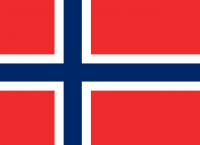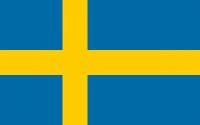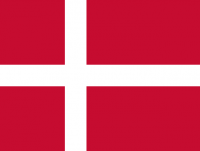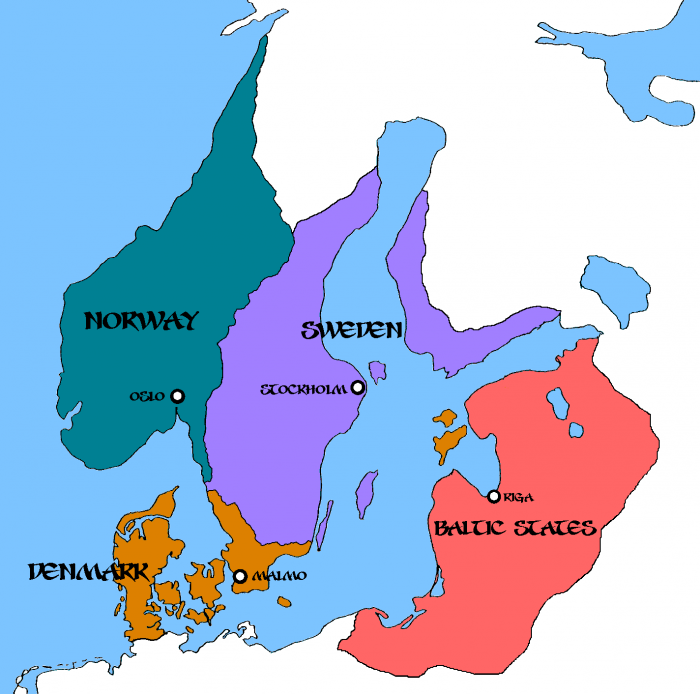Scandinavia and the Baltic States
Scandinavia
History
Norway
 The conquest and exploration of the Viking age spread the Scandinavian people far and wide, introducing them to the cultures of the rest of Europe and beyond. They formed relations with Christian monarchies and the church, and When they returned to their homelands, many of the Vikings brought Christianity back with them. This included most of the Norwegian monarchs, starting with Haakon I in 935.
The conquest and exploration of the Viking age spread the Scandinavian people far and wide, introducing them to the cultures of the rest of Europe and beyond. They formed relations with Christian monarchies and the church, and When they returned to their homelands, many of the Vikings brought Christianity back with them. This included most of the Norwegian monarchs, starting with Haakon I in 935.
By 1035, Christianity was established as the dominant religion with a Christian monarch holding the crown. Around 1130, the aristocracy had grown discontent with the expansion of the direct rule of the monarchy. The church was successful in exploiting this civil unrest to become independent of the throne.
At this time, all royal children, legitimate or otherwise, had equal claim to the crown as long as they were accepted by a lagting, a meeting of all the highest ranking chieftains. In 1173, the church backed pretender Magnus V Erlingsson as king, in return for his obedience to the pope and an issuance of a letter of privileges for the church. He was opposed by Ingrid Ragnvaldsdotter who sought instead to revoke the independence of the church. After many years of fighting, Ingrid has just succeeded in being acknowledged as Queen of Norway.
Sweden
 The trade routes established during the Viking age were particularly important for Sweden. The trade of furs to the Baltics and Russia proved very lucrative, and lead directly to the founding of the town of Birka for this purpose. Rather than through royal endorsement as in Norway, Christianity was spread to Sweden by missionaries from France, England, Norway and even Russia. Paganism proved difficult to remove, but the church did not give up and by the early 11th century it finally gained royal support.
The trade routes established during the Viking age were particularly important for Sweden. The trade of furs to the Baltics and Russia proved very lucrative, and lead directly to the founding of the town of Birka for this purpose. Rather than through royal endorsement as in Norway, Christianity was spread to Sweden by missionaries from France, England, Norway and even Russia. Paganism proved difficult to remove, but the church did not give up and by the early 11th century it finally gained royal support.
Even at this time, however, Sweden was more a loose federation of provinces than a unified entity under a single rule. Monarchs of the various provinces occasionally proclaimed themselves ruler of all of Sweden, but in reality did not usually exert much power of anywhere but their own province.
This changed in the middle of the 12th century, when the rivals Sverker and Erik were each crowned monarch of roughly one half of Sweden. They fought viciously for control of the country, and eventually both died in battle against each other. This battle was declared a victory for Erik's forces, however, and after the deaths of the two rivals in 1177, Erik's son Knut was accepted as king of the entire country.
Denmark
 It was primarily the Danes who lead the Viking invasions of Northern England, leading to the formation of the Danelaw, until they were driven out in 954 by the unified Kingdom of England. The Danes also held parts of Norway around this time, although lost, regained, and lost it again in subsequent years. Together with the rest of Scandinavia, Denmark was Christianised by around the 11th century.
It was primarily the Danes who lead the Viking invasions of Northern England, leading to the formation of the Danelaw, until they were driven out in 954 by the unified Kingdom of England. The Danes also held parts of Norway around this time, although lost, regained, and lost it again in subsequent years. Together with the rest of Scandinavia, Denmark was Christianised by around the 11th century.
Sweyn II Estridsen was in power during the decline of the Viking age at the end of the 11th century. Despite royal succession being in the hands of the things, local assemblies of the citizens, five of Sweyn's children took the throne in order between 1074 and 1134. This period was characterised by regular conflict over the extent of the monarch's power. This eventually led to civil war, and the kingdom was divided between three contenders.
After much fighting, Valdemar I emerged victorious and became acknowledged as sole king in 1157. He initially recognised Holy Roman Emperor Barbarossa as his feudal superior, but then rejected the relationship and firmly established Denmark as an independent kingdom. Absalon took to the throne after their father's death in 1182, with their sibling Valdemar II at their side.
Politics
The Viking age is coming to a close. The regular waves of invaders, traders, explorers and colonists that have emanated from this region for several hundred years are finally abating. The rulers of Sweden and Norway have turned their attention inward. Norway is now struggling with outbreaks of civil war; Ingrid has been declared queen of all Norway, but with strong opposition from the church it is unclear how long that will last. She seeks to bring the church back under royal control, while her opponent, Magnus V, would instead make the monarchy obedient to the pope.
King Knut of Sweden may have the majority of the population behind him, but he is not without opposition. Surviving members of the Sverker clan still contest his rule and will do everything they can to bring him down. Knut has responded by viciously cracking down on any hint of treason, forcing the Sverker clan to resort to ever more extreme measures.
In Denmark, the desire for conquest still burns, but now looking East to the Baltic States. The ruler Absalon, directing their armies in a more coherent manner than the semi-random wanderings of the Vikings, has just succeeded in conquering the islands off the coast west of Riga. This could be considered a threat to the sea trade routes between the Baltic States and Scandinavia, although no attempt to blockade the region has been made, at least not yet. Although only Absalon is recognised as monarch, they work closely with their sibling, Valdemar II, and rarely make an independent decision.
Culture
Christianity has spread through Scandinavia, and now only a few pockets of pagan tradition remain. The recent monarchs of Sweden and Norway have been Christian and encouraged the proliferation of the religion. Remnants of the old ways can still be seen in local customs, but these countries can now be considered as Christian as Britain. While Viking activity has waned, the trade routes already established are still strong and prosperous. These links extend across Europe, all the way from Britain to Byzantium. Scandinavian sailors are famed for their skill and their ships are a common sight in every port.
The epic Viking saga remains a popular form of entertainment throughout Scandinavia. The stories of the Old Gods have fallen out of favour with the Christianisation of most of the population, but historic tales are as popular as ever, and the arrival of the fae provided much material for new legends to be told.
Notable Figures
Queen Ingrid Ragnvaldsdotter
Queen Ingrid of Norway has recently defeated King Magnus Erlingsson, her most prominent rival to the throne, and secured the monarchy in terms of military might. However, the Church, previously allied with Magnus, still opposes her. Despite her hereditary claim to the throne, being the last surviving direct descendant of the last uncontested monarch, she has more care for politics than religion. This has put her in poor standing with the clergy: whilst this may seem like a minor inconvenience for a ruler, she now has trouble holding her political position with the church against her.
King Knut Eriksson
Knut, like his father, is a devout Christian, and has granted the church a separate system of taxation as well as the right to administer justice. He has managed to hold on to the crown for 10 years despite stiff opposition from the rival Sverker clan. He is quiet and contemplative, but will not hesitate to resort to extreme measures if they are deemed necessary.
Absalon of Denmark
Little is known, but much is speculated, about the secretive ruler of Denmark. The one thing known for certain is that they are ambitious; the recent invasion into the Baltic islands was considered a bold move by the other rulers of the region, but Absalon's forces quickly took the lands before anything could be done to stop them. Few can say more than that, however. The only person who might know Absalon well at all is Valdemar, their sibling. The two are rarely seen apart and it is almost as rare to see them in close conversation with anyone else.
Baltic States
Politics
The area known as the Baltic States is inhabited by a large number of independent groups of people, ranging from small tribes to medium-sized states. Contact with the wider world was introduced by the Vikings, who made extensive use of the river systems to establish trade routes.
In 1187, the geopolitical landscape of the region is a complicated one. The Estonians in the north are split between eight major districts and four minor ones; south from there, the Livs are split between four large areas in Latvia and northern Courland. The ten principalities of the Prussians form the westernmost part of the Baltics, while the Jotvingians and Galindians occupy the area to the south. Lithuania is home to the Samogitians and the Aukstaiciai. Five more subdivisions occupy Latvia and - well, you get the idea. As such, these people do not present a strong unified force and are constantly struggling with invasions from Scandinavia in the West and the Slavs in the East. That is in addition to infighting among themselves; there are many skirmishes over borders, although none of the political groups seems to be able to act cohesively enough to make much headway with expansion. Given the small size of a lot of the states, it would surely not take much to tip the scales in someone's favour.
Geography
 Expansion is likely also hampered by the rough terrain that separates many of the states, from the Ural mountains to the forests and swamplands of Lithuania. These areas can be very tricky to navigate, and natural dangers are compounded by local tribes who often do not take kindly to visitors. The rivers that permeate the land do offer a means of access for trade, however, assuming you can find someone friendly enough to make deals with. The trade of amber, in both its raw form and crafted into jewellery, has proven lucrative here, with a large natural abundance of the material. The coastal port of Riga is a hub for trade in the region, with its own branch of the Mercantile Guild.
Expansion is likely also hampered by the rough terrain that separates many of the states, from the Ural mountains to the forests and swamplands of Lithuania. These areas can be very tricky to navigate, and natural dangers are compounded by local tribes who often do not take kindly to visitors. The rivers that permeate the land do offer a means of access for trade, however, assuming you can find someone friendly enough to make deals with. The trade of amber, in both its raw form and crafted into jewellery, has proven lucrative here, with a large natural abundance of the material. The coastal port of Riga is a hub for trade in the region, with its own branch of the Mercantile Guild.
Culture
These lands are currently in the middle of their conversion to Christianity, but the old Gods of the area and their nature-worshipping traditions remain strong in many areas, and even in nominally Christian areas the sacred oak groves are still an important part of the local culture. Folk songs known as dainos (singular: daina) are very popular in the region. These four-line songs are common in almost every aspect of life, from religion and legend to weddings and work songs.
Notable Figures
Queen Liudmina of Prussia
Queen of Prussia, the westernmost provinces of the Baltic States, Liudmina is concerned by the recent rapid expansion by the Danes into the islands north of her lands. She believes an invasion of her lands is imminent, and talks of dealings with dark forces on the side of Absalon and their armies.
Oskars, Warden of the Sacred Groves
A kindly old man, if sometimes more than a little absent-minded, he is head of a band of wandering pagan priests who tend to the sacred groves. Some say he is nothing more than a glorified gardener, an old man tending to shrubs. Others say that his time spent devoted to the groves has granted him knowledge and power beyond that of a mortal man - though they have little evidence to back up these wild claims.
Chieftain Mindaugas
Mindaugas is a prominent chieftain among the Lithuanian tribes. Of all the tribal leaders, he is one of the most concerned with the encroaching influence of the rest of Europe. He appears keen to learn what he can about the rest of the world while remaining tight-lipped about the state of affairs in his own country.

